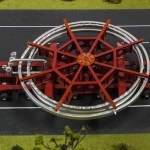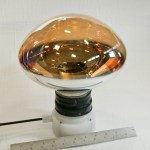fermilab
Big science is a massively collaborative endeavor. From the initial theoretical puzzles to the brilliant engineers that build on-of-a-kind machinery, experts come together to make discoveries happen. Case in point: We’re moving this 50-foot-wide physics experiment over 3,200 miles of land, sea, and river, starting on Long Island, NY and ending in Batavia, IL. Sometimes understanding the fabric of the universe requires a very technical and very long journey.
The 50-foot-wide muon ring assembled at Brookhaven Lab.
The experiment is called Muon g-2 (pronounced gee-minus-…
"Give me a coin. <Takes Coin.> All right. Uh... heads, I win, tails, you lose. Right? <Flips coin.> Tails, you lose." -Ralph Kramden
All things being equal, you're well aware that if you flipped a completely fair coin, you'd have a 50% chance of it landing on heads, and a 50% chance of landing on tails (ignoring the side, of course).
Image credit: C. Nolan, A. Eckhart and Warner Bros. Pictures, retrieved from http://explow.com/Two-Face.
So let's imagine that you flip the coin ten times, and you get seven heads and three tails. Are you worried? You shouldn't be; in…
How do scientists make glass stronger? Break it.
Brookhaven Lab physicists and engineers take this hands-on approach a step further. In order to strengthen the design of glass bulbs known as photomultiplier tubes, the researchers submerge the devices in 500,000 gallons of pressurized water, punch a small hole through their sides, and watch as the glass cracks, crunches, and, just milliseconds later, implodes (see videos below).
The implosion of a photomultiplier tube in a tank at BNL, as seen through combined high-speed camera images. Time scale: 6,000 frames per second.
Fifty thousand…
If you're American, chances are you'll be looking up this weekend for a spectacle of physics. But you also can look down from above -- way, way above -- to see the homes of some of the greatest physics experiments on Earth.
Brookhaven's Relativistic Heavy Ion Collider (RHIC) is probably one of the most visible particle accelerators from space.
Check out this satellite shot from 1982, when construction was underway for RHIC's predecessor, ISABELLE:
And this more recent aerial shot, taken in May:
RHIC is the first machine in the world capable of colliding heavy ions, which are atoms that…
tags: Alex Filippenko, Josh Frieman, FermiLab, astronomy, astrophysics, Science Bulletins, research, American Museum of Natural History, AMNH, New York City, space, nature, universe, The Expanding Universe, streaming video
In 1998, astrophysicists discovered a baffling phenomenon: the Universe is expanding at an ever-faster rate. Either an enigmatic force called dark energy is to blame or a reworking of gravitational theory is in order. In this new Science Bulletins video, watch a FermiLab team assemble the Dark Energy Camera, a device that could finally solve this space-stretching mystery…


